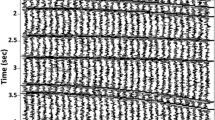Abstract
Depth conversion of selected seismic reflections is a valuable procedure to position key reflectors in depth in a process of constructing or refining a depth-velocity model. The most widespread example of such procedure is the so-called map migration, in which normal-incidence, zero-offset (stacked) seismic data are employed. Since the late seventies and early eighties, under the assumption of an isotropic velocity model, map migration algorithms have been devised to convert traveltime and its first and second derivatives into reflector position, dip and curvatures in depth. In this work we revisit map migration to improve the existing algorithms in the following accounts: (a) We allow for fully anisotropic media; (b) In contrast to simple planar measurement surface, arbitrary topography is allowed, thus enlarging the algorithms applicability and (c) Derivations and results are much simplified upon the use of the methodology of surface-to-surface paraxial matrices.
Similar content being viewed by others
References
Biloti R., Santos L.T. and Tygel M., 2002. Multiparametric traveltime inversion. Stud. Geophys. Geod., 46, 177–192.
Bortfeld R., 1989. Geometrical ray theory: Rays and traveltimes in seismic systems (second-order approximation of the traveltimes). Geophysics, 54, 342–349.
Červený V., 2001. Seismic Ray Theory. Cambridge University Press, Cambridge, U.K.
Duchkov A. and de Hoop M.V., 2010. Extended isochron rays in prestack depth (map) migration. Geophysics, 75, S139–S150.
Fomel S. and Tanushev N., 2009. Time-domain seismic imaging using beams. SEG Expanded Abstracts, 28, 2747–2752.
Gelchinsky B., Berkovitch A. and Keydar S., 1999. Tmultifocusing homeomorphic imaging, part i: Basic concepts and formulas. J. Appl. Geophys., 42, 229–242.
Gjøystdal H., Reinhardsen J.E. and Ursin B., 1984. Traveltime and wavefront curvature calculations in three-dimensional inhomogeneous layered media with curved interfaces. Geophysics, 49, 1466–1494.
Gjøystdal H. and Ursin B., 1981. Inversion of reflection times in three-dimensions. Geophysics, 46, 972–983.
Goldin S.V., Hermont A.J. and Hubral P., 1986. Seismic Traveltime Inversion. Investigations in Geophysics, Vol 1. Society of Exploration Geophysicists, Tulsa, Oklahoma.
Hubral P., 1983. Computing true-amplitude reflections in a laterally inhomogeneous earth. Geophysics, 48, 1051–1062.
Hubral P. and Krey T., 1980. Interval Velocities from Seismic Reflection Time Measurements. Society of Exploration Geophysicists, Tulsa, Oklahoma.
Iversen E., 2004. The isochron ray in seismic modeling and imaging. Geophysics, 69, 1053–1070.
Iversen E., 2006. Amplitude, Fresnel zone, and NMO velocity for PP and SS normal-incidence reflections. Geophysics, 71, W1–W14.
Iversen E. and Gjøystdal H., 1984. Three-dimensional velocity inversion by use of kinematic and dynamic ray tracing. SEG Expanded Abstracts, 3, 643–645.
Kleyn A.H., 1977. On the migration of reflection time contour maps. Geophys. Prospect., 25, 125–140.
Moser T.J. and Červený V., 2007. Paraxial ray methods for anisotropic inhomogeneous media. Geophys. Prospect., 55, 21–37.
Popov M. and Pšenčík I., 1978. Computation of ray amplitudes in inhomogeneous media with curved interfaces. Stud. Geophys. Geod., 22, 248–258.
Tygel M., Ursin B., Iversen E. and Hoop M.D., 2012. Estimation of geological dip and curvature from time-migrated zero-offset reflections in heterogeneous anisotropic media. Geophys. Prospect., 60, 201–216.
Ursin B., 1982. Time-to-depth migration using wavefront curvature. Geophys. Prospect., 30, 261–280.
Yilmaz O., 2000. Seismic Data Analysis, Vol. 1. Investigations in Geophysics, Vol 1. Society of Exploration Geophysicists, Tulsa, Oklahoma.
Author information
Authors and Affiliations
Corresponding author
Rights and permissions
About this article
Cite this article
Tygel, M., Ursin, B., Iversen, E. et al. Estimation of geological dip and reflector curvature from zero-offset seismic reflections in heterogeneous anisotropic media. Stud Geophys Geod 56, 521–531 (2012). https://doi.org/10.1007/s11200-011-0256-2
Received:
Revised:
Accepted:
Published:
Issue Date:
DOI: https://doi.org/10.1007/s11200-011-0256-2




